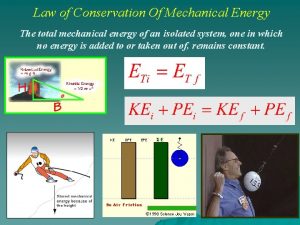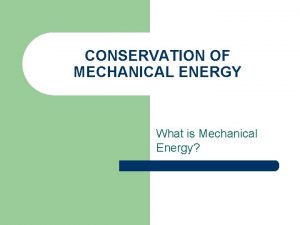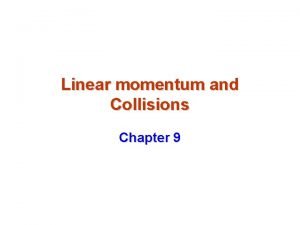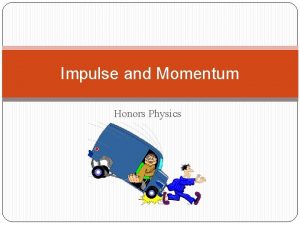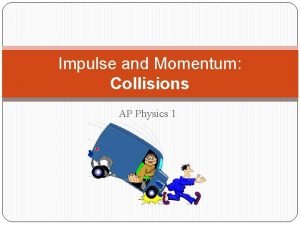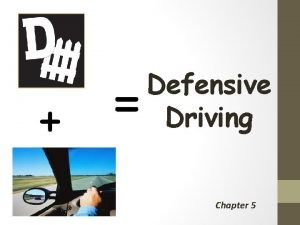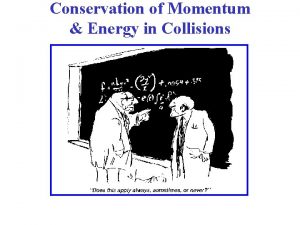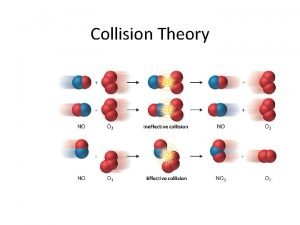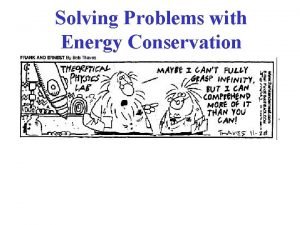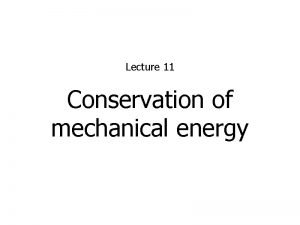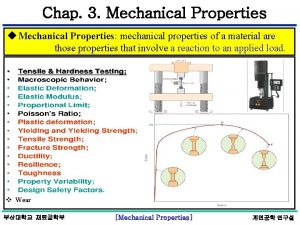Introduction to Mechanical Energy Energy Conservation Collisions conservation





















- Slides: 21

Introduction to Mechanical Energy • Energy Conservation • Collisions • (conservation of momentum and energy in collisions)

Kinetic Energy: The energy of Motion � What are the SI units for KE? › kg • m 2/s 2 or N • m or J

Potential Energy associated with an object’s potential to move due to an interaction with its environment › A book held above the desk › An arrow ready to be released from the bow � Some types of PE are listed below: › Gravitational › Elastic › Electromagnetic �

Gravitational Potential Energy � What are the SI units? › kg • m 2/s 2 or N • m or J � The height (h) depends on the “zero level” chosen where PEg = 0.

What do you think? � What is meant when scientists say a quantity is conserved? � Describe examples of quantities that are conserved. › Are they always conserved? If not, why?

Mechanical Energy (ME) � ME = KE + PEg + PEelastic › Does not include the many other types of energy, such as thermal energy, chemical potential energy, and others � ME is not a new form of energy. › Just a combination of KE and PE

Conservation of Mechanical Energy The sum of KE and PE remains constant. � One type of energy changes into another type. � › For a falling book, the PE of the book changed into KE as it fell. › As a ball rolls up a hill, KE is changed into PE.

Collisions � To analyze collisions we consider two thing: › Conservation of Momentum › Conservation of Energy

What do you think? • Two skaters have equal mass and are at rest. They are pushing away from each other as shown. • Compare the forces on the two girls. • Compare their velocities after the push. • How would your answers change if the girl on the right had a greater mass than her friend? • How would your answers change if the girl on the right was moving toward her friend before they started pushing apart?

Momentum During Collisions � When the bumper cars collide, F 1 = -F 2 so F 1 t = -F 2 t, and therefore p 1 = - p 2. The change in momentum for one object is equal and opposite to the change in momentum for the other object. � Total momentum is neither gained not lost during collisions.

Conservation of Momentum � Total momentum remains constant during collisions � The momentum lost by one object equals the momentum gained by the other object � Conservation of momentum simplifies problem solving.

Practice Problem �A 62. 0 kg astronaut on a spacewalk tosses a 0. 145 kg baseball at 26. 0 m/s out into space. With what speed does the astronaut recoil? �Answer: -0. 0608 m/s or -6. 08 cm/s � Does a pitcher recoil backward like the astronaut when throwing the ball? Explain.

Practice Problem � Zach is a quarterback and Jake is a defensive lineman. Zach’s mass is 75. 0 kg and he is at rest. Jake has a mass of 112 kg, and he is moving at 8. 25 m/s when he tackles Jake by holding on while they fly through the air. With what speed will the two players move together after the collision? � Answer: 4. 94 m/s

What do you think? • Collisions are sometimes described as elastic or inelastic. To the right is a list of colliding objects. 1. 2. 3. 4. • • Rank them from most elastic to most inelastic. What factors did you consider when ranking these collisions? 5. 6. 7. A baseball and a bat A baseball and a glove Two football players Two billiard balls Two balls of modeling clay Two hard rubber toy balls An automobile collision

Perfectly Inelastic Collisions � Two objects collide and stick together. › Two football players › A meteorite striking the earth Momentum is conserved. � Masses combine. �

Inelastic Collisions � Momentum is Conserved: � m 1 iv 1 i +m 2 iv 2 i = m 1 fv 1 f +m 2 fv 2 f � Kinetic energy is less after the collision. › It is converted into other forms of energy. �Internal energy - the temperature is increased. �Sound energy - the air is forced to vibrate. � Some kinetic energy may remain after the collision, or it may all be lost.

Practice Problems � An 2. 0 x 105 kg train car moving east at 21 m/s collides with a 4. 0 x 105 kg fully-loaded train car initially at rest. The two cars stick together. Find the velocity of the two cars after the collision. › Answer: 7. 0 m/s to the east � Now calculate the kinetic energy of the two cars before and after the collision. Was kinetic energy conserved? › Answer: KEbefore= 4. 4 x 107 J, KEafter= 1. 5 x 107 J �KE is not conserved. It is less after the collision.

Elastic Collisions Objects collide and return to their original shape. � Kinetic energy remains the same after the collision. � Perfectly elastic collisions satisfy both conservation laws shown below. �

Elastic Collisions � Two billiard balls collide head on, as shown. Which of the following possible final velocities satisfies the law of conservation of momentum? › vf, A = 2. 0 m/s, vf, B = 2. 0 m/s › vf, A = 0 m/s, vf, B = 4. 0 m/s › vf, A = 1. 5 m/s, vf, B = 2. 5 m/s � Answer: all three m = 0. 35 kg v = 4. 0 m/s v = 0 m/s

Elastic Collisions � Two billiard balls collide head on, as shown. Which of the following possible final velocities satisfies the law of conservation of kinetic energy? › vf, A = 2. 0 m/s, vf, B = 2. 0 m/s › vf, A = 0 m/s, vf, B = 4. 0 m/s › vf, A = 1. 5 m/s, vf, B = 2. 5 m/s � Answer: only vf, A = 0 m/s, vf, B = 4. 0 m/s m = 0. 35 kg v = 4. 0 m/s v = 0 m/s

Types of Collisions
 Kinetic formula
Kinetic formula Principle of conservation of mechanical energy
Principle of conservation of mechanical energy How is mechanical energy conserved?
How is mechanical energy conserved? Conservation of mechanical energy examples
Conservation of mechanical energy examples Conservation of energy
Conservation of energy Kinetic energy
Kinetic energy Forms of energy include
Forms of energy include The change in mechanical energy
The change in mechanical energy What is the formula for elastic collision
What is the formula for elastic collision Chapter 7 energy conservation of energy
Chapter 7 energy conservation of energy How to convert mechanical energy to electrical energy
How to convert mechanical energy to electrical energy Light energy examples
Light energy examples Motor working principle
Motor working principle Actual mechanical advantage vs ideal mechanical advantage
Actual mechanical advantage vs ideal mechanical advantage Types of collisions/ impulse graphs answer key
Types of collisions/ impulse graphs answer key Perfectly elastic collision
Perfectly elastic collision Impulse and momentum relationship
Impulse and momentum relationship Impulse definition physics
Impulse definition physics To avoid collisions a defensive driver should
To avoid collisions a defensive driver should Perfect inelastic collision
Perfect inelastic collision Elastic vs inelastic
Elastic vs inelastic Diagram of collision theory
Diagram of collision theory

